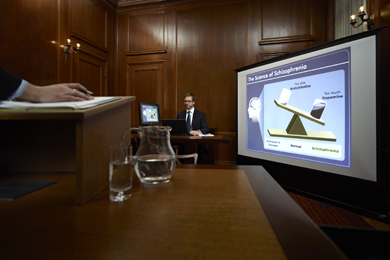Captivate the Jury: Important Components of a Powerful Test Discussion
Necessary elements such as recognizing the audience, crafting a compelling story, and mastering verbal and non-verbal interaction are essential parts of an effective discussion. As these factors intertwine, they form a cohesive strategy that not just informs yet also involves jurors on multiple degrees.

Recognizing Your Audience
Comprehending your target market is a pivotal element of efficient trial discussion. A successful presentation pivots on the capacity to understand the demographics, values, and predispositions of jurors. This understanding educates just how arguments are mounted, proof exists, and psychological charms are crafted, making certain that the message reverberates with the jurors on a personal degree.
Study indicates that jurors come from diverse histories and might have differing degrees of understanding pertaining to legal procedures (trial presentation). Therefore, it is essential to prevent lawful lingo that might push away or puzzle them. Rather, using clear, relatable language cultivates involvement and understanding. Additionally, understanding the jurors' potential biases and life experiences allows the trial speaker to anticipate objections and address concerns proactively.
Efficient test presentation additionally involves observing jurors' responses throughout the process. Being attuned to non-verbal hints can give insight into their involvement and understanding, permitting for real-time modifications in method. Inevitably, a profound understanding of the target market not only enhances communication however also builds relationship, enhancing the probability of a beneficial end result. Engaging with jurors as people as opposed to a cumulative unit is important in cultivating a strong link in the courtroom.

Crafting an Engaging Story
Crafting an engaging narrative is important in guiding jurors via the intricacies of an instance. A well-structured story not just simplifies elaborate legal principles however also engages jurors on a psychological level, making the information extra relatable and unforgettable.
This message ought to reverberate with the jurors' worths and experiences, promoting a connection that transcends plain facts. This sequential approach can assist jurors follow the progression of events, highlighting reason and effect.
Integrating human components-- such as individual stories or anecdotes-- can additionally boost the narrative's effect. These elements stimulate compassion, permitting jurors to imagine the repercussions of the case on the real worlds. In addition, employing a constant style throughout the discussion reinforces the main disagreement, making it much easier for jurors to preserve vital factors.
Inevitably, an engaging story changes a trial presentation from a simple recounting of realities into an influential tale that astounds the court, motivating them to ponder with both factor and emotion.
Using Visual Aids
Integrating visual help right into a trial presentation can significantly enhance jurors' understanding and retention of details. Aesthetic products such as charts, representations, photos, and videos can transform complex legal ideas and proof right into conveniently digestible styles. By involving numerous detects, these help permit jurors to imagine the situation's crucial elements, making it less complicated for them to adhere to along and understand elaborate details.
Moreover, well-designed aesthetic aids can stress important points and emphasize connections between various pieces of evidence. As an example, timelines can efficiently illustrate the series of events, while annotated photos can clear click up specific information appropriate to the case. This not only help in understanding yet likewise reinforces the story presented by the lawyer.
Overly complicated or chaotic visuals may overwhelm jurors and detract from the message. Eventually, reliable aesthetic communication can be a powerful tool in encouraging jurors and helping them reach educated verdicts.
Grasping Verbal Communication
Efficient spoken communication is vital in a trial presentation, as it functions as the main ways where attorneys communicate their disagreements and get in touch with jurors. Understanding this ability entails quality, persuasion, and engagement. Attorneys should verbalize their factors plainly and briefly, staying clear of lawful lingo that might confuse jurors. Simpleness in language cultivates more helpful hints understanding and aids jurors comprehend complex concerns presented throughout the trial.
Moreover, tone and pacing significantly impact how messages are obtained. A confident tone conveys authority, while suitable pacing permits jurors to take in info without really feeling bewildered. Attorneys ought to likewise vary their singing inflections to stress vital points and maintain jurors' passion throughout the discussion.
In addition, the organization of verbal arguments is vital. Structuring the narrative rationally and coherently assists jurors follow the attorney's line of thinking, making it less complicated for them to retain essential details. Utilizing persuasive strategies, such as storytelling, can also boost the emotional vibration of the arguments offered, consequently creating a more extensive link with jurors.
Inevitably, understanding verbal interaction not only strengthens a lawyer's case yet also cultivates count on and relationship with the jury, dramatically improving the opportunities of a positive verdict.

Engaging With Body Language
Nonverbal interaction plays an important function in trial presentations, often sharing messages that words alone can not reveal. Body language, incorporating motions, pose, faces, and eye contact, significantly affects exactly how jurors regard the trustworthiness and sincerity of the presenter. A certain position, with shoulders back and Resources an open pose, can instill trust fund, while closed-off body language may recommend defensiveness or uncertainty.

Faces should show the emotions related to the instance, strengthening the narrative existing. An honest expression during an emotional moment can elicit compassion and reinforce the emotional allure. Eventually, mastering body movement is essential for efficient trial discussions, as it boosts verbal interaction and establishes an engaging presence that reverberates with the jury.
Verdict
In final thought, captivating the court necessitates a calculated approach that includes understanding the audience, crafting an engaging story, making use of visual help, mastering verbal interaction, and engaging with body movement. Each aspect plays an essential function in producing an effective test discussion that reverberates with jurors on both psychological and intellectual levels (trial presentation). By incorporating these parts efficiently, lawful professionals can substantially enhance their capability to persuade and affect court decision-making